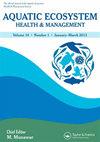劳伦斯五大湖的猎物群落:基于底拖网调查的跨流域现状和趋势概览,1978-2016
IF 0.8
4区 环境科学与生态学
Q4 ENVIRONMENTAL SCIENCES
引用次数: 5
摘要
20世纪70年代,在劳伦斯五大湖苏必利尔、休伦、密歇根和安大略省以及1990年在伊利启动了年度底拖网调查,以提供对捕食鱼类群落状况和趋势的年度评估。苏必利尔湖的捕食鱼类群落主要由当地的Cisco Coregonus artedi和Bloater C.hoyi组成。在1978-2016年的大部分时间里,休伦湖和密歇根湖的捕食鱼类群落由非本地的彩虹气味Osmerus mordax和Alewife Alosa pseudoarengus主导,但在1980-1990年代,Bloater是一个重要物种,最近已成为这些湖泊的主要捕食物种。Alewife在1978-2016年间统治着安大略湖的捕食鱼类群落。虽然非本地人在伊利湖的捕食鱼类群落中占主导地位,但在20世纪90年代末建立黑口新虾虎鱼后,本地翡翠石斑鱼是一个重要物种,偶尔也是占主导地位的捕食鱼类。在20世纪80年代至90年代,Bythotrepes cederstroemi、Dreissena polymorpha和Dreissena bugensis引起了劳伦斯五大湖生态系统的深刻变化,并可能导致密歇根湖和休伦湖鱼类群落生物量的下降。在伊利湖和安大略湖,这些入侵者的影响更为微弱。苏必利尔湖(Lake Superior)是劳伦斯五大湖(Laurentian Great Lakes)的成功故事:南马约库什湖鳟鱼(Lake Trout Salvelinus namaycush)得到了恢复,当地的猎物鱼类占据了主导地位,并支持了一个可行的渔业。尽管休伦湖和密歇根湖的斑点鱼数量最近有所增加,但本地猎物的恢复仍不确定。安大略湖的主要猎物中没有本地物种,这表明本地鱼类的恢复缺乏进展。伊利湖本地捕食鱼类的恢复情况尚不清楚。由于入侵物种的影响以及持续的气候和生态系统变化,劳伦斯五大湖不断变化的状态将继续挑战21世纪本地鱼类群落的恢复。本文章由计算机程序翻译,如有差异,请以英文原文为准。
Prey fish communities of the Laurentian Great Lakes: A cross-basin overview of status and trends based on bottom trawl surveys, 1978-2016
Annual bottom trawl surveys were initiated in the 1970s in Laurentian Great Lakes Superior, Huron, Michigan and Ontario and in 1990 in Erie to provide annual assessments of the status and trends of prey fish communities. Native Cisco Coregonus artedi and Bloater C. hoyi dominated the prey fish community of Lake Superior. Prey fish communities in lakes Huron and Michigan were dominated by nonnative Rainbow Smelt Osmerus mordax and Alewife Alosa pseudoharengus for much of 1978-2016, but Bloater was an important species during the 1980-1990s and more recently has become the dominant prey species in these lakes. Alewife dominated the prey fish community of Lake Ontario during all 1978-2016. While nonnatives dominated the prey fish community in Lake Erie, native Emerald Shiner Notropis atherinoides was an important species and occasionally the dominant prey fish after the establishment of Round Goby Neogobius melanostomus in the late 1990s. During the 1980s-1990s Bythotrephes cederstroemi, Dreissena polymorpha, and Dreissena bugensis caused profound changes in Laurentian Great Lakes ecosystems and likely contributed to declines in fish community biomass in lakes Michigan and Huron. The impacts of these invaders were more muted in lakes Erie and Ontario. Lake Superior stands out as the Laurentian Great Lakes success story: Lake Trout Salvelinus namaycush was restored, and native prey fishes dominate and support a viable fishery. Although the abundance of Bloater has increased recently in lakes Huron and Michigan, recovery of native prey fishes remains uncertain. The absence of native species among the principal prey fish in Lake Ontario indicates a lack of progress in native fish recovery. Recovery of native prey fishes remains unclear in Lake Erie. The ever-changing state of the Laurentian Great Lakes caused by the impacts of invasive species and ongoing climate and ecosystem change will continue to challenge restoration of native fish communities in the 21st Century.
求助全文
通过发布文献求助,成功后即可免费获取论文全文。
去求助
来源期刊

Aquatic Ecosystem Health & Management
环境科学-海洋与淡水生物学
CiteScore
1.70
自引率
0.00%
发文量
1
审稿时长
18-36 weeks
期刊介绍:
The journal publishes articles on the following themes and topics:
• Original articles focusing on ecosystem-based sciences, ecosystem health and management of marine and aquatic ecosystems
• Reviews, invited perspectives and keynote contributions from conferences
• Special issues on important emerging topics, themes, and ecosystems (climate change, invasive species, HABs, risk assessment, models)
 求助内容:
求助内容: 应助结果提醒方式:
应助结果提醒方式:


